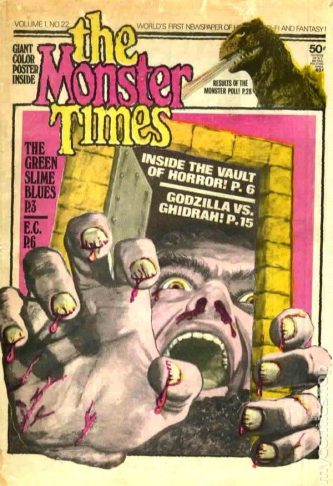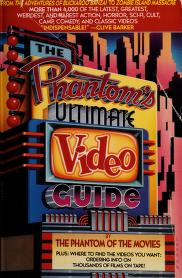 In an age filled with self-anointed “B-movie historians” the now-deceased Joe Kane remains one of the very few writers who can truly be said to have earned that designation. He was a film reviewer whose affection for the disreputable was genuine and infectious. So too his engaging and unpretentious prose, which remains virtually unprecedented in a field that admittedly isn’t known for great writing, and the fact that he wasn’t afraid to risk Hollywood’s wrath by calling out substandard work.
In an age filled with self-anointed “B-movie historians” the now-deceased Joe Kane remains one of the very few writers who can truly be said to have earned that designation. He was a film reviewer whose affection for the disreputable was genuine and infectious. So too his engaging and unpretentious prose, which remains virtually unprecedented in a field that admittedly isn’t known for great writing, and the fact that he wasn’t afraid to risk Hollywood’s wrath by calling out substandard work.
Kane admittedly never received the same adulation as his colleagues Bill Landis, Rick Sullivan and Michael Weldon have in the cult movie sphere, which is due largely to Kane’s mainstream credentials. He wrote extensively for the New York Daily News, which made his comrades “jealous as all hell” (that’s according to Sullivan, writing in the final issue of Gore Gazette, wherein he also concedes that Kane’s later publication The Phantom of the Movies’ VIDEOSCOPE—see below—is “quite an informative tome”). But of course Kane did in fact have a fair amount of underground accreditation, having edited and done quite a bit of writing for the legendary Monster Times.
From its first issue in June 1972, The Monster Times was notable for its newspaper format (beating later newsprint periodicals like Mediascene and Search and Destroy to the punch) and for being the true bridge between Famous Monsters of Filmland and Fangoria. The Monster Times was staunchly fan-based in its celebration of monster cinema, but tempered its enthusiasm with an East Coast counterculture sensibility. Featured was Kane’s indispensable multi-part “Mushroom Monsters” (showing that his inimitable voice arrived fully formed), an exhaustive overview of 1950s nuclear war themed genre films, as well as articles on Hong Kong horror, the cinema of H.G. Lewis and so-bad-it’s-good fare, which appeared long before any of those things became fashionable.
Following The Monster Times’s demise in 1976 (Fangoria reportedly tried to revive it in the early 00s) Kane took an editing position at Screw magazine and freelanced for several years in publications such as The Village Voice, High Times and Penthouse (which published Kane’s sci fi satire “Death After Death,” a fun trifle featuring a caricature of Screw’s publisher Al Goldstein, in its October 1978 issue). The New York Daily News gig followed in 1984, wherein Kane donned his “Phantom of the Movies” persona in a column of that title and a companion feature entitled “Mondo Video.”
Showcased in these columns was Kane’s ability to adroitly sum up a film’s qualities, or lack thereof, and relevant background info in a single paragraph, something that (speaking as one who’s tried it) is not nearly as easy as it looks. But for me, who didn’t read the Daily News, the highlight of Kane’s columns was the companion book THE PHANTOM’S ULTIMATE VIDEO GUIDE.
To this young film buff the discovery of that 756 page book back in 1989 was a revelation. It marked my first exposure to arcane but fascinating subjects like the eighties B-movies scripted by the late Philip Yordan and the bizarre cult item THE CARRIER (about which Kane writes “the sight of crazed fundamentalists, wrapped in protective plastic trash bags, cheerfully chopping each other to bits is a rather novel and compelling one”), grouped into sections and packed with fun sidebars (such as an “Aliens Say the Darndest  Things!” one, consisting of outrageous quotes from grade-Z sci fi movies like “You see, you see! You’re stupid! Stupid!”). I say it’s the finest of the 1980s cult movie guides (which included CREATURE FEATURES MOVIE GUIDE, THE PSYCHOTRONIC ENCYLOPEDIA OF FILM and CULT MOVIES) and an absolute must for any true cultist.
Things!” one, consisting of outrageous quotes from grade-Z sci fi movies like “You see, you see! You’re stupid! Stupid!”). I say it’s the finest of the 1980s cult movie guides (which included CREATURE FEATURES MOVIE GUIDE, THE PSYCHOTRONIC ENCYLOPEDIA OF FILM and CULT MOVIES) and an absolute must for any true cultist.
It was followed by Kane’s most iconic publication, The Phantom of the Movies’ VIDEOSCOPE, which began as, essentially, a pamphlet in January 1993, and morphed into one of the longest-running cult movie magazines on the market. It was indeed one of the best such mags (ranking with Filmfax, The Dark Side and Psychotronic Video), and a fitting follow-up to The Monster Times, with Kane’s voice and sensibilities fully evident throughout each issue, in which the highly individual formatting of the ULTIMATE VIDEO GUIDE was replicated. Also included were fun features by other writers, including Tim Ferrante’s “Truth from the Booth” column about his adventures as a movie theater projectionist in the 1970s, and copious interviews, many of them with cult figures you probably won’t find profiled anywhere else (such as THE PARTY ANIMAL’s Matthew Causey).
In 2000 Kane released another book, THE PHANTOM OF THE MOVIES’ VIDEOSCOPE: THE ULTIMATE GUIDE TO THE LATEST, GREATEST, AND WEIRDEST GENRE VIDEOS, essentially an updated version of the ULTIMATE VIDEO GUIDE. Other Kane authored publications include 2010’s NIGHT OF THE LIVING DEAD: BEHIND THE SCENES OF THE MOST TERRIFYING ZOMBIE MOVIE EVER (admittedly something of a done-to-death subject, but the book is as thorough a guide to NIGHT OF THE LIVING DEAD as any you’ll find), the baseball novel THE SAGA OF SIX FINGER PIKE (described as “John R. Tunis meets David Lynch in the Twilight Zone”) and a 2018 memoir entitled FOUND FOOTAGE: HOW THE ASTRO-ZOMBIES SAVED MY LIFE AND OTHER TALES OF MOVIE MADNESS.
Now, of course, Joe Kane has joined his cult movie reviewer follows Bill Landis, Chas. Balun and Rick Sullivan in the afterlife. In their absence the cult movie field will carry on, but with a rather large hole in its make-up.
